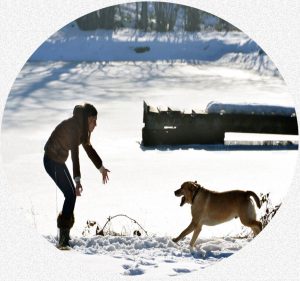Kennel Cough In Your Dog
Infectious Tracheobronchitis, The Canine Infectious Respiratory Complex And Fellow Travelers
Ron Hines DVM PhD
 So many different germs make me cough!
So many different germs make me cough!
 Which vaccines for my dog and when?
Which vaccines for my dog and when?
My Dog Was Diagnosed With Kennel Cough – What Is That?
Like the “colds” we catch, “kennel cough” is a catch-all term for a large number of different germs. All of them can make your dog cough, and perhaps feel a bit under the weather. Year after year, the number of infectious organisms veterinarians can link to coughing dogs grows. And just like our common colds, the results can be no more than a passing annoyance lasting a day or two, or something serious enough to visit your veterinarian. And like colds, on rare occasion, the problem will morph into something more serious (pneumonia) – almost always that is when other serious health issues are lurking in the background.
Veterinarians’ proper term for kennel cough is infectious tracheobronchitis. Many people still associate kennel cough with a bacteria, Bordetella bronchiseptica. But bordetella rarely if ever causes kennel cough on its own. When bordetella is involved, it is generally only one of many players in a complex interaction between your dog’s immune system and an assortment of other viral and bacterial pathogens all working in tandem to cause respiratory tract inflammation. Those other players include the dog parainfluenza virus, an adenovirus, a coronavirus and a number of others, all of whom I will tell you about as you read on. You can also read about all of them as they affect dogs in Europe through the German Shepherd link at the top of this page.
Alone, few if any of these organisms produce more than a mild, transitory respiratory illness – or no problem at all. But together, in the right situations or in predisposed pets, they have a combined group power to make your dog ill. Many healthy dogs carry one or more of these organisms in their respiratory system. Wherever many of these healthy carrier dogs gather, such as in boarding kennels, dog shows, training programs or long lines at mobile vaccination clinics, they exchange these organisms. That leads to new combinations of bacteria and virus that leave some of the dogs open to tracheal and bronchial inflammation (tracheobronchitis). Stress goes hand-in-hand with boarding and shelter situations. Your dog would never choose to be away from you, its pack leader and best friend. How dogs handle separation varies from dog to dog. Elderly dogs in particularly do not handle owner-separation well. Under stress or anxiety situations, health issues already present exacerbate and can lower their ability to fight infections of all kinds.
Besides A Dry Cough, What Other Signs Might My Dog Develop?
Only a few dogs go on to develop secondary problems that produced exudate in their lungs (pneumonia). Those are often one of the short-faced breeds or those with pre-existing health issues. Toy breeds prone to collapsing tracheas are also prone to longer episodes of coughing after exposure to kennel cough virus and bacteria. I mentioned that most dogs experience only a dry, hacking cough, perhaps sneezing and, perhaps, a subdued temperament. It is harder for your veterinarian to observe minor mood changes that you might have described at home. First you know your dog’s normal temperament better and secondly, dogs during office visits are generally too alert and too preoccupied to exhibit what they do at home. Laryngitis can affect the tenor of their bark. Their tonsils might be enlarged and bulging from their crypts. That can affects their appetite and stimulate gagging or wrenching. If so, bubbly, mucus phlegm is usually all that is produced. Light pressure on their windpipe often brings on a period of coughing, as does a tight collar or taunt leash. The presence or absence of a low fever is unpredictable. So is the presence of eye and/or nasal exudate (discharges & crusts).
What Tests Might My Veterinarian Run?
Several commercial laboratories offer respiratory disease panels that search for and identify the organisms present in the respiratory tract of dogs. Most of these tests do not attempt to grow or visualize the organisms. They rely on the PCR technique to amplify the distinctive DNA/RNA of each of these organisms The samples submitted from a dog are generally swabs taken from your pet’s throat (pharyngeal swabs) and/or nose. However, these tests have their limitations. For one, as I mentioned earlier, perfectly normal-looking dogs often carry some of these same organisms. Samples submitted more than a few days after the infection began can have too few organisms left to determine which initiated the coughing problem in the first place, particularly if antibiotics were already given when the samples were obtained. Where these tests are most helpful is in developing a treatment and/or management plan for animal shelters or large animal care compounds where samples from many ill and healthy dogs, submitted at the same time, might give clues as to how to best approach and reduce a continuing problem.
The Bacteria Associated With Kennel Cough:
Bordetella bronchiseptica
Bordetella bronchiseptica is not particular which species of animal it inhabits. Besides dogs; cats, pigs, ferrets, Polar bears, guinea pigs and rabbits often carry the organism. When respiratory symptoms occur in them, it is often one of the organisms identified. On rarer occasion, elderly, infant and immunosuppressed people are susceptible to its pathology as well. (read here) The location of choice for Bordetella is adjacent to the respiratory cilia that line your dog’s larger lung passages (its trachea & bronchi). These cilia are the “brooms” that are constantly sweeping inhaled debris, dust, mucus and bacteria forward and out of your dog’s lungs. The plentiful mucus that the dog’s respirator system naturally secretes traps invading organisms and that, along with its immune system, normally limit bordetella’s ability to do damage. Under conditions of stress, the bordetella bacteria could, perhaps, act alone to cause kennel cough. But with the list of secondary players increasing year by year, that has not been adequately established. On occasion, bordetella is isolated from severe pneumonia in dogs or from the lungs of puppies that have inhaled milk (aspiration pneumonia). The importance of its role in those situations also remains unclear.
Mycoplasma
Mycoplasma (sometimes called mollicutes) are an extremely small variety of bacteria. Many different species of mycoplasma have been isolated from dogs – some of those dogs showed respiratory tract issues, and some did not. When mycoplasma are detected, suspicion often falls on Mycoplasma cynos because it is a common resident of coughing dogs. But as with bordetella, healthy dogs often carry it too. (read here & here) Although some antibiotics inhibit mycoplasma, they are quite difficult to totally eliminate from the respiratory tract. (read here)
Other Bacteria
Other bacteria, such as Streptococcus zooepidemicus, Pseudomonas, E. coli, and Klebsiella have also been isolated from the respiratory tract of dogs with infectious coughs. What parts they play in kennel cough remains unknown. Another bacterial group, the Chlamydophila, are also occasionally isolated from coughing dogs. (read here) Preferred organism names frequently change. Chlamydophila and chlamydia are not currently the same thing.
The Viruses Associated With Kennel Cough
Adenovirus CAV-2
A virus that is often isolated from dogs with kennel cough is the canine adenovirus-2 (CAV-2). It is one of the many ingredients in the vaccines that your dog receives. Some dogs will develop a cough within a week of being exposed to this virus. In some dogs, the CAV-2 virus also produces conjunctivitis, sneezing and a nasal discharge. But one study found that 12.5% of non-coughing dogs at US animal shelters harbored the virus. (read here) When your dog is exposed to just this virus alone, the signs are generally quite mild or unnoticeable. But as with the rest, when your dog is exposed to it along with other villains, the cough and malaise can be more serious. The shots your dog received against distemper and parvovirus, generally also contained weakened (attenuated) CAV-2 virus. That is because CAV-2 gives cross-protection against CAV-1, the virus that causes infectious canine hepatitis.
Canine Parainfluenza Virus
Like the canine Adenovirus-2, weakened parainfluenza virus is included in most of the vaccine formulas that include distemper and parvovirus. It is also included in intranasal/oral “kennel cough” vaccines such as Elanco’s Bronchi-Shield® III or Zoetis’ Vanguard® RR-3. As with the other virus and bacteria associated with kennel cough, the signs of parainfluenza virus are indistinguishable from the others. None of the parainfluenza virus-containing vaccines claim to prevent infection with this virus (they do not confer “sterile” immunity). What they do claim is that they tend to make infections with these virus less severe when they occur.
Canine Coronavirus
Like the adenovirus, this virus also comes in two forms: A contagious intestinal form that can be found in dogs all around the world (CCV group 1) and a respiratory tract form (CRCoV) group 2 that is usually mild. It is unclear if these two viruses have the ability to merge. It is also unclear if these virus poses any threat to humans. (read here)
Canine Pneumovirus
Several years ago, Veterinarians in the UK and at Cornell University isolated yet another virus from coughing dogs housed at animal shelters. It proved to be a pneumovirus. The virus still causes localized outbreaks of respiratory disease in dogs around the world. (read here & here) Where – if anywhere – it fits into the kennel cough complex remains to be determined.
Canine Influenza Virus CIV
Canine influenza is usually considered a separate, and potentially more serious disease than kennel cough. But the symptoms overlap. When they are mild, the symptoms of CIV are indistinguishable from kennel cough (although CIV is more associated with fever than the disease agents I mentioned up until now). When CIV gets into a large group of dogs such as a racing greyhound stable, 60-80% are likely to begin to show signs in 2-5 days. The virus is usually out of their system 7 days later. When signs last longer, they are usually due to the organisms associated with kennel cough being involved as well. Vaccines against CIV minimize the risk of your dog developing respiratory tract signs like sneezing, coughing and malaise, but they do not altogether prevent infection. The lifestyle risk factors for your dog catching CIV are the same as those for kennel cough.
Canine Distemper Virus
Like canine influenza, the dog distemper virus is not a part of the kennel cough complex. But like canine influenza, the early signs of distemper often include a cough and other signs that might be mistaken for kennel cough. The weakened immune system that canine distemper induces also gives the organisms involved in kennel cough and other health issues an increased opportunity to prosper and cause illness.
Canine Herpes Virus
We usually think of the herpes virus of dogs as a cause of sudden death in puppies. Read about that here. Once an adult dog is exposed to that virus and recovers, just as in human herpes and chickenpox, the virus tends to persist (in latency) in its body for life. However, in dogs that are not newborn, nor fully mature, the herpes virus of dogs has the ability to cause symptoms that mimic those of kennel cough. (read here) It might even be capable of doing so in mature carrier dogs when they are subjected to stress or drugs that suppress their immune systems (e.g. corticosteroids, cyclosporin etc.).
Reoviruses
Murine (mouse) reoviruses (MRVs) are not very particular in which species they reside. They have been isolated from the respiratory tracts of dogs with kennel cough. What part, if any, they play in the disease has yet to be determined.
Vaccines
There are three forms of kennel cough vaccines on the market: intranasal, oral and injectable. Bronchi-Shield® and Vanguard® B Oral formulas only contain bordetella – offering no protection against the other common organisms involved in kennel cough. The injectable products I am familiar with only offer protection against bordetella. My preference is for products that are administered in your dog’s nose. The intranasal vaccine against kennel cough that I use protect against bordetella, canine adenovirus-2 and parainfluenza. I believe that intranasal vaccines are more likely to stimulate local immunity where it is needed – in your dog’s nose and upper respiratory system. (read here) One study I know of found that that was also the case in dogs. (read here) Giving these vaccines and other vaccines less than 5 days before boarding your dog is unlikely to afford much, if any, protection (some say a minimum of 7-10 days before).
What Options Does My Veterinarian Have To Treat Kennel Cough?
Once your veterinarian has eliminated possible non-infectious causes for your dog’s cough, antibiotics are probably something you will leave with. There is a lot of pressure on veterinarians to dispense them, even when they are not required. No surveys I know of give the most preferred antibiotics to use for kennel cough in the United States. But in Australia, doxycycline, amoxicillin/clavulanate (Clavamox®), enrofloxacin (Batryl®), amoxicillin and cephalexin lead the list. (read here) Antibiotics are of no value in in treating the viral organisms that are most often also involved. In the USA, add chloramphenicol to the list and downgrade Clavamox® and ampicillin because of the ability of bordetella to become resistant to them. Batryl® is frowned upon in immature dogs because of its possible negative effects on immature joint development. In severe cases, some veterinarians have nebulized gentamycin for kennel cough dogs to inhale. Cough suppressant (antitussive) medications (such as Temaril-P® and Hycodan®) should be reserved for severe cases. The former contains a steroid that can suppress immune function. The second, a narcotic, can decrease the ability of your dog’s respiratory tract to clear itself of mucus and debris. Over the counter cough suppressants are not particularly effective. Bronchodilators have little effect on cough. If your dog is running a fever, your veterinarian might prescribe a dog-safe NSAID. Dogs that have difficulty breathing on their best of days due to their breed, generally need more intensive treatment than better-proportioned dog breeds. Your veterinarian will probably tell you to give your dog a comfortable warm environment and plenty of rest. Your vet might suggest you not do anything that encourages your dog to bark. He/she might ask you to be sure its collar is not too tight and suggest you use a harness rather than a leash until its cough resolves. If poor appetite is a problem, consider a canned or home-cooked diet rather than a dry one. Let your veterinarian know if the problem persists or get worse.
Let them know if the consistency, amount or color of your pet’s nasal discharge changes or if its respiratory rate or effort increases. Listlessness and lack of appetite are never good signs. The vast majority of kennel cough cases resolve without complications. But veterinarians never want the problem to progress to pneumonia – so they will want to keep track of your dog as it recovers.
Avoiding Kennel Cough
The best prevention is to avoid exposing your dog to other non-family dogs. Wandering cats also carry and spread many of these same organisms – so keep your cats indoors. All of the situations that would make you more likely to catch a cold are the same situations that make it more likely for your dog to catch kennel cough. The primary way these respiratory tract viruses and bacteria travel to your dog is through another dog. Anything that lowers your pet’s resistance increases its susceptibility. A study quoted by the U. Wisconsin Veterinary School, reported that each additional day that a dog remained in an animal shelter increased its risk of developing kennel cough by 3%.
You are on the Vetspace animal health website
Visiting the products that you see displayed on this website help pay the cost of keeping these articles on the Internet.

